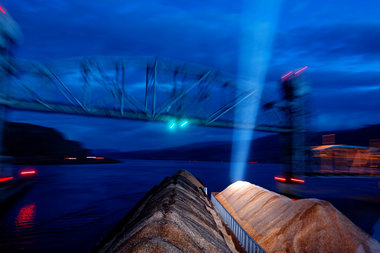forum
library
tutorial
contact

Railroad Tracks
Would Cost $4 Million
by Elaine Williams
Lewiston Tribune, April 14, 2014
|
the film forum library tutorial contact |

|
Railroad Tracks
by Elaine Williams
|
 It would cost an estimated $4 million to construct railroad tracks that would accommodate 110 cars for a unit train in the Lewiston North Port area.
It would cost an estimated $4 million to construct railroad tracks that would accommodate 110 cars for a unit train in the Lewiston North Port area.
That's the single most expensive proposed project contained in a study just completed for the Port of Lewiston, Lewis-Clark Metropolitan Planning Organization and the Lewis-Clark Terminal, which fills bulk grain barges bound for Portland, Ore.
Traffic experts were tasked with identifying the biggest needs in the rail, truck and barge transportation hub. Other possibilities include another estimated $1.63 million to expand carload rail service and $1.5 million in improvements to 18th Street North and 20th Street North.
"It's nice to have everybody at the table talking about what's possible. Everything is baby steps, but it is a good tool," said Jaynie Bentz, assistant manager of the Port of Lewiston.
Bentz spoke at a recent meeting of the metropolitan planning organization where the study was reviewed. Some of the tracks for the unit train would be split into four sections that would run parallel north of Third Avenue North. A line that runs next to the Clearwater River would be extended east, too.
The existing rail lines could accommodate three times the volume they do now with no major investment for one to two years, according to the study.
But the consideration of infrastructure for a unit train is necessary because of what's happening in the railroad industry.
Unit trains are trains that carry one type of cargo leaving from one destination and heading to the same place. The trains can be as long 7,500 feet with 110, 66-foot cars or as short as 3,400 feet with 60, 49-foot cars.
"In the last decade, larger Class I railroads, such as Union Pacific Railroad, and Burlington Northern Santa Fe Railway, have tried to reduce the number of cars in non-unit train service they handle, thus reducing their staffing and traffic congestion at terminals" in areas like Pasco and Hermiston, Ore., according to the study.
As significant as unit trains are, carload service still has advantages because it provides the most flexibility for the shipper and receiver, according to the study.
Carload service is smaller groups of cars, which are moved in general merchandise trains and are assembled at railroad terminals, according to the study.
"The rail infrastructure (for carload service) ... can be built in small phases as the need increases."
Additional rail improvements could be put at the former Longview Fiber site west of the railroad bridge along the Clearwater River, according to the study.
The port owns the land and some rail infrastructure is already there, according to the study, which doesn't provide any additional detail about that idea.
The street improvements are aimed at creating defined main routes through the port, improving visibility where 18th Street North and 20th Street North intersect with State Highway 128 and separating vehicle traffic from pedestrians and bicycles.
The latter two groups are factors in the primarily industrial area because of a transit route, businesses where people work and its proximity to the Old Spiral Highway up Lewiston Hill, a popular bicycle route.
Even more work could be needed in the North Port district than the study outlines. Redoing Sixth Avenue North is not mentioned. That street was singled out two years ago by David Doeringsfeld, Lewiston's port manager, because it had visible cracks.
Figuring out how to afford the concepts in the study will be one of the next steps. A number of state and federal programs might help cover the costs, said Lisa Key, a senior planner with Spokane consulting firm David Evans and Associates.
Additionally, tax increment financing from Lewiston's Urban Renewal Agency might be tapped, Key said. The Port of Lewiston was not listed as a potential source of revenue.
The study doesn't prioritize what should be pursued first. It is also not intended as a laundry list. Instead community leaders will likely make choices based on what business emerges for the port, Key said, "You have to be light on your feet and you have to have some contingency plans."
Bob Tippett, chairman of the Nez Perce County Commission and former executive director of Valley Vision, pointed out that waiting until an entrepreneur wants a port location could be too late, since it would likely take years to complete some of the initiatives. "We might lose that opportunity."
Related Pages:
Barge Traffic at Lewiston, Idaho's Only Port, Falls Again by Elaine Williams, Idaho Statesman, 3/26/14
learn more on topics covered in the film
see the video
read the script
learn the songs
discussion forum
